The pictures below show the process for making oatcakes.
Use the arrows to make your way through.
Riddle
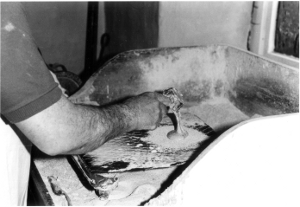 The mix, or
batter, is poured onto a layer of oatmeal on the riddling board. It
is then riddled which makes it into a circular pool floating on the
oatmeal. It is then transferred to the machine, which changes it to
an oval shape.
The mix, or
batter, is poured onto a layer of oatmeal on the riddling board. It
is then riddled which makes it into a circular pool floating on the
oatmeal. It is then transferred to the machine, which changes it to
an oval shape.
The term riddling may derive from the act of
sieving which is a similar action (but it might not).
The Machine
 The oatcake throwing machine was patented in the 19th century and
comprises a truck on rails and a linen belt driven from the truck
axle.
The oatcake throwing machine was patented in the 19th century and
comprises a truck on rails and a linen belt driven from the truck
axle.
Working alone Alan would produce one oatcake every 40
secs.
With a second person "turning", the rate would increase
to one every 25 secs.
Throwing the Oatcake
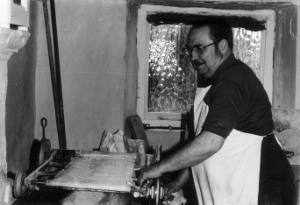 The oatcake is thrown from the machine onto a
hotplate. This was originally coal fired but was converted to gas in
the 1960's. The steel hotplate was treated with a "face" of shelac
which makes makes it easier to "turn". The oatcake is stretched to
its full size in this process.
The oatcake is thrown from the machine onto a
hotplate. This was originally coal fired but was converted to gas in
the 1960's. The steel hotplate was treated with a "face" of shelac
which makes makes it easier to "turn". The oatcake is stretched to
its full size in this process.
Turning the Oatcake
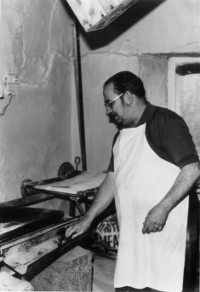 The oatcake is scraped off the face with a flexible
knife about 40cm long by 5cm wide picked up by hand and transferred
to the second hotplate.
The oatcake is scraped off the face with a flexible
knife about 40cm long by 5cm wide picked up by hand and transferred
to the second hotplate.
Finishing the Oatcake
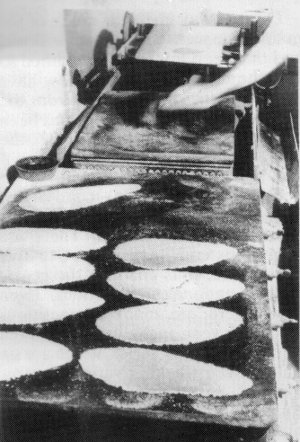 After turning the cooking process is finished off on
the cooler second hotplate seen here in the foreground. In the back
ground the face is being prepared for another oatcake, already on
the machine, to be thrown.
After turning the cooking process is finished off on
the cooler second hotplate seen here in the foreground. In the back
ground the face is being prepared for another oatcake, already on
the machine, to be thrown.
Cooling on the "Cratch"
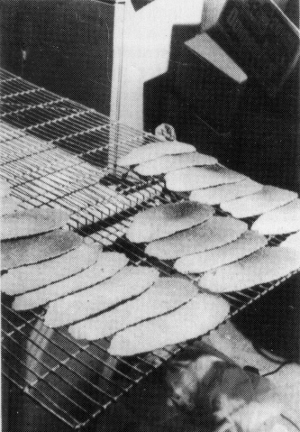 After the oatcakes have finished cooking on the
hotplate they are removed to the cratch where they are left to cool.
After the oatcakes have finished cooking on the
hotplate they are removed to the cratch where they are left to cool.
Cratch is an old english word meaning a rack for food.
Packed in the Basket
 When cool the oatcakes were then packed, in piles of a
dozen, in boxes or baskets ready for delivery.
When cool the oatcakes were then packed, in piles of a
dozen, in boxes or baskets ready for delivery.
The baskets
were made at a workshop for blind people in Burnley and was a
preferred storage as it allowed the contents to breathe.